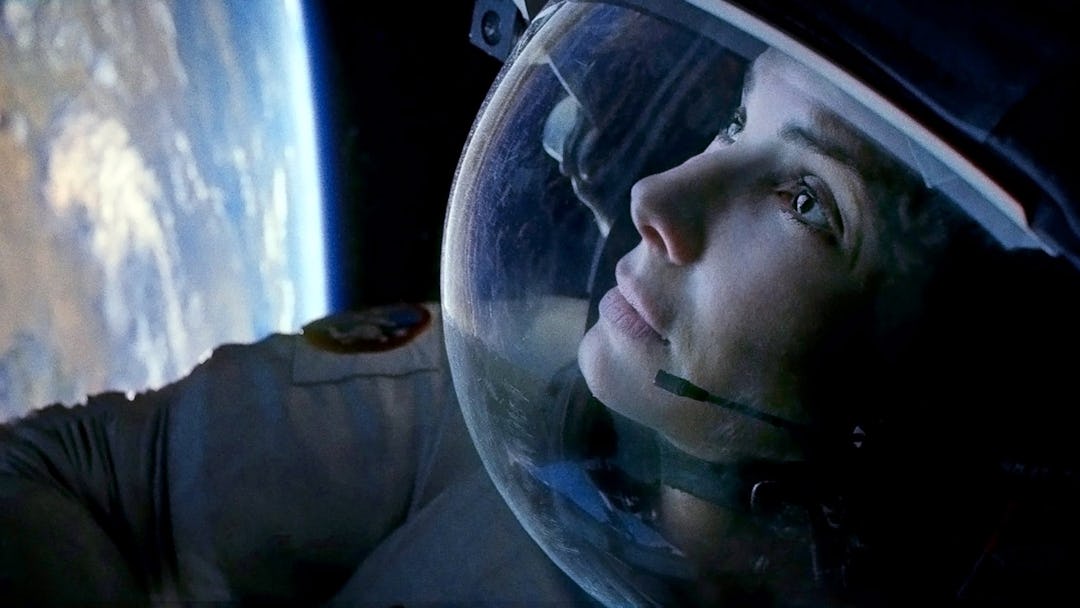There’s a key image that appears two or three times in Alfonso Cuarón’s Gravity, of a single, solitary figure, floating off into the deep, black void of space. It is a powerful visual, encompassing both the genuine awe of the setting, and the utter terror of the situation. “Life in space is impossible,” an early title card reads, and we’re given no reason to think otherwise.
Cuarón’s previous film, Children of Men, was renowned for its complex, seemingly uninterrupted shots, and Gravity opens with a similar one, his camera lazily circling a space shuttle as an astronaut works while another enjoys a space walk. The worker is Dr. Ryan Stone (Sandra Bullock), installing a photographic system; the walker is Matt Kowalsky (George Clooney), who sums up their roles thus: “You’re the genius up here, I just drive the bus.” (The voice of Houston mission control is provided by Apollo 13 and The Right Stuff’s Ed Harris, a nice touch.) It is a scene of character establishment and levity, cut brutally short in mid-sentence. “Mission abort,” demands Houston. An out-of-nowhere shower of debris quickly rips apart their shuttle, kills a colleague, and untethers Stone.
All of this happens before the first visual cut, in an opening sequence that is like a slowly tightening vice. From that point on, their mission shifts from one of exploration to one of survival. “Set your watch for 90 minutes,” commands Kowalsky — the point at which another meteor shower will hit. After the earlier impact, Stone is sitting at a 10% oxygen level. Their communication with NASA has been severed, so they preface their status updates, with only the dimmest of hopes, with “Houston, in the blind…” The remainder of the film (which runs a scant 91 minutes) concerns the possibility of making it out of this mission alive — and the ramifications of that realization. “We’re all gonna die, everybody knows that,” Stone confesses. “But I’m gonna die today.”
Bullock’s casting, which looked to be either an unimaginative ingratiation of easy box office or a desperate second choice (Angelina Jolie and Natalie Portman were among the many actors considered before her), seems, in the film’s final form, the only wise one, her girl-next-door “America’s sweetheart” profile the perfect avatar for the average moviegoer. She’s a researcher, not a space jockey; she’s got nausea and six months of training and doesn’t really know what the hell she’s doing up there, and when the weight of what has happened dawns on her (during a head-to-toe spin that seems unlikely to ever end), we’re with her.
Then again, I’m hard pressed to recall the last time I felt this invested in a film protagonist. Dr. Stone has a story, which is revealed carefully and organically, and Cuarón shifts gears so quickly, with such ease and control, that it’s astonishing — you’re moved from thrills to tears in a blink. Gravity’s peerless action sequences and genuine scares are receiving the lion’s share of the ink, and to be sure, it is a fucking relentless narrative. In his efficient construction of clear narrative obstacles and clean pursuit of those goals, he’s approaching something like pure cinema. But these are not empty thrills; Cuarón is tackling the elemental questions of the human experience here, albeit in a larger form and on a grander scale than most. It is a big, bold picture that refuses to be timid, and it left me trembling. It’s not just a film; it’s something that happens to you. This is what moviegoing is all about.
Gravity is out today in wide release.
